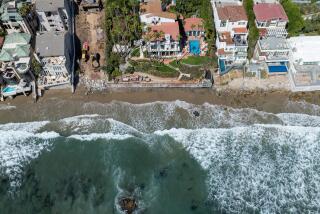Once-Ugly Silver Strand Takes on Rich Luster of Platinum
- Share via
Development in the Silver Strand area just west of Marina del Rey is less than 10 years old, but already the neighborhood may have outlived its name.
“It’s a misnomer,” said Mary Legg, a real estate broker and a pioneer in the development of the Strand. “They should have called it the Platinum Strand.”
In less than a decade, the Strand--a sliver of land two blocks wide and 10 blocks long wedged between Venice and Marina del Rey--has been quietly transformed from an ugly, scarred and pitted oil field into an architecturally eclectic mix of multilevel, million-dollar single-family homes.
“The area looks like a movie set,” said Santa Monica architect Marshall Lewis, who has designed five houses on the Silver Strand.
Indeed, the combination of big houses of many styles crammed together on small lots gives the area a slightly unreal, movie-backdrop appearance. The impression is enhanced by the serene Ballona Lagoon--home to a surprising variety of shore birds--which many of the homes face.
Homes in the interior of the Strand are separated by landscaped malls. One of the remaining footbridges built by Abbot Kinney, the father of Venice, crosses the waterway to connect the Strand with the Venice community and beach.
Despite the traffic and noise of adjacent Marina del Rey’s restaurants and crowded apartment complexes, the area remains a hideaway. Most days on the Strand are free of either vehicular or pedestrian traffic.
It is that insulation, with proximity to urban Los Angeles, that has made the area attractive to working professionals.
Randy Epstein, a Strand homeowner and a broker with Darrell Lee & Associates in Marina del Rey, said the Strand could become even more desirable than Malibu for working professionals because it offers a waterfront location and is closer to downtown Los Angeles, to freeways and to Los Angeles International Airport.
“This is the last area other than Malibu in which you can have a large single-family home and still walk to the beach,” he said. “Yet it’s closer to everything.”
The demand for housing has led to skyrocketing prices for land and homes.
Twenty years ago, the 35-by-90-foot lots were worth about $20,000, but today those lots are valued closer to $500,000.
Real estate broker Darrell Lee, who has sold 50 to 60 lots since 1981, said the amount of appreciation has surprised him.
“My personal forecast was that lots would only go up to $250,000,” he said. “Now I wish I had kept some (land).”
Homes, many featuring atriums and rooftop decks, start at $1 million. Epstein said 3,000- to 5,000-square-foot homes have been appreciating by about $200,000 to $250,000 a year in the last three years.
“I predict that by next year we could be hitting the $2-million mark for homes,” Epstein said.
Although development started in the early 1980s, the Silver Strand got its name and was subdivided in 1906 by Kinney, who built the Venice canals, which feed into the Ballona Lagoon. But it remained a subdivision on paper, and development became even less of a priority when oil was discovered in the area in 1930. For nearly 40 years, the Strand was a forest of oil pumps and wells.
By the late 1960s, dwindling oil field production combined with development of Marina del Rey in the adjacent county-owned wetlands revived interest in the Silver Strand. Because Los Angeles County retained ownership of all the land in Marina del Rey, developers with long-term leases concentrated on building a rentals-only community there.
But the Strand was located in the city of Los Angeles and privately owned, allowing for the development of single-family homes.
In 1972, voters created the state Coastal Commission to oversee development near the beach. Heightened awareness about the environment meant a growing resistance to development.
“It was never about the environment,” Legg said recently as she sat in a trailer outside three homes she and her son, Dan, are building on Via Dolce. “They thought they were trying to stop a bunch of rich people looking to build an exclusive community near the beach. But we were just a bunch of regular people who happened to own those lots.”
After a five-year fight, building permits were issued. The city of Los Angeles, however, said it would be several years before it could build streets, sewers and lights for the area.
In 1979, about 150 property owners banded together to raise $4.5 million to build the infrastructure themselves. The first homes were built in 1983.
Real estate brokers say the Silver Strand remains something of a secret because it was developed by several individual property owners without any major marketing.
More to Read
Sign up for Essential California
The most important California stories and recommendations in your inbox every morning.
You may occasionally receive promotional content from the Los Angeles Times.






